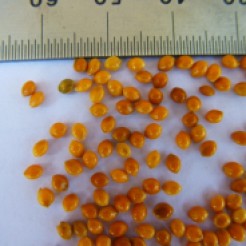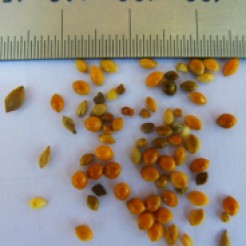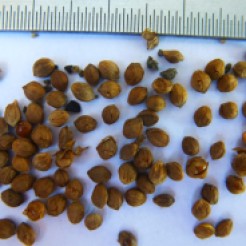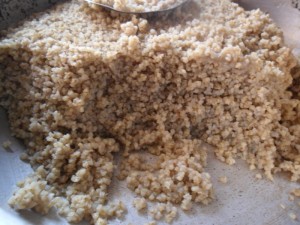– by Dr. Adithya Pradyumna, MBBS, MPH (London), PGDip (Environment)
editing assistance: Dwiji Guru.
The arguments presented regarding millets being goitrogenic, typically rely both on population level survey studies of goitre and on lab based biochemical studies. There are two stages to the argument:
1. Studies in some populations that consume millets as a staple have shown unusually high prevalence of goitre.
2. The alleged mechanism for this process is plausibly the presence of compounds (polyphenolics – flavonoids) which have anti-iodine metabolism and anti-thyroid activities, as has been apparently been demonstrated in animal and tissue studies.
What is goitre?
It is the term used to denote a swelling in the neck caused by the enlargement of the thyroid gland (due to whatever reason). Such an enlargement of the gland may be associated with normal secretion of thyroid hormone, or inadequate secretion (hypothyroidism) or increased secretion (hyperthyroidism). The most common reason for goitre is iodine deficiency, associated with either normal or low thyroid secretion (NHS, 2015).
Other factors accounted for/isolated?
The papers linking goitre to millet-consuming populations are based on survey data. It is unclear whether the analysis has adequately considered the potential role for alternative explanations, such as a general state of malnutrition or chronic low iodine intake. A preliminary search through Google Scholar has not revealed the presence of a systematic review on this subject, which would have helped clarify matters more easily.
One of the cited studies was conducted in Sudan, which showed that the urinary excretion of iodine (UIE) was normal in a population with 22% prevalence of goitre, which means the population probably consumed normal levels of iodine (at least in the short term), and so the goitre may have had something to do with the inappropriate metabolism of the iodine within the body (Elnour et al., 2000). The children with goitre had normal thyroid hormone levels, which may have occurred through compensatory enlargement of thyroid gland. Here the inference taken was that as the iodine levels in urine was normal, the high millet diet potentially did not allow appropriate metabolism. But it is important to also note that the researchers did not adequately study chronic iodine deficiency or document the diets completely (to understand sources of iodine and quantity of millet consumption), or other potential explanations for the phenomenon. A high prevalence of protein-energy malnutrition along with multiple vitamin deficiencies was also prevalent in this population, which could potentially explain, at least in part, the derangement in thyroid hormone metabolism.
In the cited Gujarat study (Brahmbhatt et al., 2000), there was UIE was low in 54% of the population (indicating low iodine intake at least in the short term) and mild to moderate goitre was seen in 23% of the children (indicating chronic iodine deficiency). This may indicate goitre due to low dietary intake itself (at least that would be the first suspect). UIE and goitre may not correlate due to these being indicators of acute vs chronic status of iodine respectively (Elnour et al., 2000). Surely there is a need for more hypothesis driven empirical research to understand the extent to which millet consumption can interfere with normal thyroid metabolism, and the other dietary conditions that predispose to such a situation (what percentage of diet, what combination of diet, how it is cooked etc).
Which of the millets are we talking about?
That some millets contain flavonoids (a goitrogenic substance) appears to be well known – pearl millet (Cordain, 2014), and in relatively smaller amounts in ragi (FAO, n.d.). A preliminary search has not revealed information on the presence of goitrogens in other millets. This point is important, as each millet is quite different from the other. Taxonomically the various millets are classified into more than 5 different genii under the family poaceae. There are so many differences- from structure to chemical composition, and hence nutritional composition- between say pearl millet, one of the most widely used naked grain millets in the world, and foxtail millet one of the most widely consumed of the husked grains classified under millets. It would be similar to saying hominids are the same.
How much & in what form?
Rats fed on fermented bajra (in animal studies) have resulted in goitre (Cordain, 2014). But the question now is how much bajra and in what form will one have to consume for it to be dangerous for thyroid metabolism? Each variety of millet possesses different levels of these compounds. Also, the method of preparation and cooking affects the level of these compounds. It may be worthwhile discussing the preparation method while discussing potential for risk in a particular context. A relatively old FAO document provides a great degree of details on preparation methods for millets (FAO, n.d.). Traditionally and locally employed approaches will need to be looked into in various millet consuming communities.
Risks and benefits weighed?
The same flavonoid compounds which are apparently anti-thyroid, have also been reported to be potentially very beneficial to health as anti-oxidants (from an anti-cancer and anti-aging perspective) (Shahidi and Chandrasekara, 2013). So, even if it comes to pass that millets may slightly increase risk of thyroid disorders, it will have to weighed against its role in reducing population risk to cancer and other age related disorders. This kind of calculation has been conducted in several other cases (such as for the questions on whether salmon should be consumed as they contain detectable levels of polychlorinated biphenyls or PCBs, where it has been recommended that eating salmon will still have far greater health benefits than the risks posed by trace levels of PCBs).
Iodine in the diet
Iodine is most abundant in fish. For those not consuming marine products, iodine is primarily obtained through vegetables and pulses. Iodine is present in the soil, but the content in soil is reducing due to various causes of mismanagement of soil. Iodine fortification of salt (NHS, 2015) has become the policy makers response to this apparent public health challenge. Some studies in India have indicated that a partial contribution to iodine deficiency, because of an inability to absorb Iodine, could be due to thiocynates in the diet. Those compounds are primarily seen in the brassica group of vegetables, and also in jowar. But some studies indicate that for thiocyanate to cause health impacts, the diet would need to be deficient in iodine (Agarwal, 2008).
One American endocrinologist stated: “Basically the goitrogens are challenges to the thyroid. But in the absence of iodine deficiency, substantial or prolonged ingestion of dietary goitrogens and lastly the absence of an underlying thyroid disorder, the risk in this country of having problems in this area are very, very low, almost minuscule. Again, that’s because the vast majority of people have adequate iodine levels to counteract the effect of goitrogens.” (Zimmerman, 2014) So, if we interpret this argument in the Indian context, where it has been estimated that approximately 350 million don’t take enough iodine in the diet (Pandav et al., 2013), the poor intake of iodine would need to shoulder a good part of the responsibility for hypothyroidism.
Opinion was also sought from Dr Anoma Chandrasekara, Head of the Department of Applied Nutrition of Wayamba University, Srilanka, who mentioned “My personal idea is millets can be a beneficial component in a balanced diet…. So if the area we consider is deficient in iodine and if there are no strategies to overcome the problem such as salt iodization, consuming foods (not only millet, but even some vegetables) that contain goitrogenic factors can aggravate the problem. But in societies in nutrition transition, millet like foods can contribute towards health food choices. I think moderation of food selection and balance of different food types should be key for optimal health. According to what I notice in Sri Lanka with occurrence of more and more NCDs, our traditional foods that had disappeared are appearing on the table again. Millet is one of them. We should promote millet like grains. But if iodine deficiency is a problem in the area need to address separately” (Chandrasekara, 2016).
Millets in traditional food systems
Millets have been consumed in local rural and adivasi/aboriginal communities for generations. Millets are almost never eaten exclusively (even in situation of extreme poverty it is eaten with salt and some spices, based on anecdotal reports) – it is consumed with other vegetables, pulses or meat. They are prepared in many different ways and some of these processes, such as malting, tempering prior to milling, and germination, have been studied and shown to reduce the levels of “anti-nutrients” (FAO, n.d.). one should note that some of these processes could affect the level of other nutrients.
For populations that have traditionally eaten millet diets, such as in Karnataka, there have not been reports or anecdotal exchanges of endemic goitre. There is scope for such a study in areas where millets consumption is prevalent even to this day.
Conclusion
There are several foods that contain goitrogens and a couple of millets have been identified to do so too. The level of these compounds present in various millets is still unclear and more studies are needed to identify that.
Millets are old food, very old in fact. And the notion and evidence of millets containing “anti-nutrients” is also not very new (FAO, n.d.). Millets, it appears, was and is primarily considered an important measure of food security for the poor from arid areas where nothing else grows. It is only recently that the health benefits of millets and their use disease management has increased their appeal to the whole population. There surely is some basis for calling them “healthy food”. There are warnings that there might be some not so desirable components too. But there are many communities around the world that have lived and survived primarily due to their millet centric diets.
It is preferred to have a reasonable diversity in diet, and in sufficient quantities to nourish ourselves. It appears that millets in a balanced vegetarian or non-vegetarian diet should not cause problems, especially one in which there is adequate iodine intake. Practicing the precautionary principle, in particular for pregnant mothers and children who are in greater need for normal thyroid metabolism to ensure appropriate brain and physical development, one should ensure adequate intake of iodine by consciously including Iodine rich foods or supplemented food items like iodized salt.
There are also ways in which millets can be cooked to reduce even the minor risk that may be associated with them, without losing any of its other health benefits. A diet that includes millets is especially beneficial from the glucose metabolism perspective. The many different millet options also offer an unparalleled opportunity for diversifying the cereal component of our diets.
References
Agarwal, K.N., 2008. Iodine Deficiency and Endemic Goiter: A National Tragedy. Indian Pediatr. 454–455.
Brahmbhatt, S., Brahmbhatt, R.M., Boyages, S.C., 2000. Thyroid ultrasound is the best prevalence indicator for assessment of iodine deficiency disorders: a study in rural/tribal schoolchildren from Gujarat (Western India). Eur. J. Endocrinol. Eur. Fed. Endocr. Soc. 143, 37–46.
Chandrasekara, A., 2016. Query regarding phenolics in millets.
Cordain, L., 2014. Millet: A Gluten-Free Grain You Should Avoid : The Paleo DietTM [WWW Document]. Paleo Diet. URL http://thepaleodiet.com/millet-gluten-free-grain-avoid/#.VtaDF9DGAgT (accessed 3.2.16).
Elnour, A., Hambraeus, L., Eltom, M., Dramaix, M., Bourdoux, P., 2000. Endemic goiter with iodine sufficiency: a possible role for the consumption of pearl millet in the etiology of endemic goiter. Am. J. Clin. Nutr. 71, 59–66.
FAO, n.d. Sorghum and millets in human nutrition [WWW Document]. FAO Corp. Doc. Repos. URL http://www.fao.org/docrep/t0818e/t0818e0j.htm (accessed 3.2.16).
National Nutrition Monitoring Bureau, 2003. Prevalence of micronutrient deficiencies (No. 22). National Institute of Nutrition, ICMR, Hyderabad, India.
NHS, 2015. Goitre [WWW Document]. NHS. URL http://www.nhs.uk/Conditions/Goitre/Pages/Introduction.aspx (accessed 3.2.16).
Pandav, C.S., Yadav, K., Srivastava, R., Pandav, R., Karmarkar, M.G., 2013. Iodine deficiency disorders (IDD) control in India. Indian J. Med. Res. 138, 418–433.
Shahidi, F., Chandrasekara, A., 2013. Millet grain phenolics and their role in disease risk reduction and health promotion: A review. J. Funct. Foods 5, 570–581. doi:10.1016/j.jff.2013.02.004
Zimmerman, R., 2014. Thyroid Doc: Kale Risks “Theoretical” But In Reality, Very Low To Minuscule [WWW Document]. Wburs Commonhealth. URL http://commonhealth.wbur.org/2014/01/thyroid-doc-kale-problems-theoretical-but-in-reality-very-low-to-minuscule (accessed 3.2.16).















